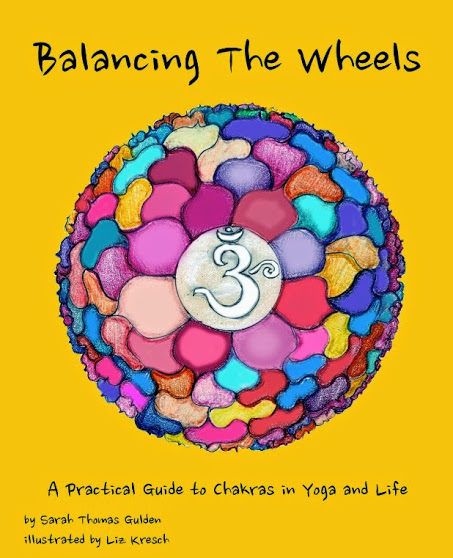
This is a book about patterns for people who like patterns.
I have confession to make: Until recently I only had a cursory understanding of the chakras. I knew the ‘locations’ of each, the colors and energies associated with them and some of the basic yoga poses to help realign the chakras when they were out of balance. But that was the extent of my knowledge.
For this reason I was thrilled when I was asked to review Balancing the Wheels: A Practical Guide to Chakras in Yoga and Life by Sarah Thomas Gulden. I cannot completely express how useful and informative I found this book.
I have read it through twice—-once cover to cover and once flipping back and forth through each section depending on which chakra I felt I should focus on—-and found it immeasurably insightful and enlightening both times. In fact, I put off writing this review for a few weeks because I wanted to test some of the suggested practices described within before I commented on the book as a whole.
Sarah Thomas Gulden admits from the very start that it would be impossible for her to discuss each chakra in any amount of detail—-whole books have been written about each one individually. Rather, she states that her goal in writing the book was to provide an introduction for those (like me) who needed an approachable primer or for it to serve as a window through which one could look at life and and practice as a means of self-healing.
Gulden explains that the chakra system is not linear—-as it is often portrayed in imagery—-but is actually a wheel with no beginning or end. Therefore, although the Muladhara chakra is the root and is located at our base, it is deeply affected by the balance (or imbalance) of both the Swadisthana chakra as well as the Sahasrara chakra. This idea of a non-linear continuum of energy working through my Self helped me to see chakra work from an entirely different perspective.
As the author clarifies in her preface, this is a book about patterns for people who like patterns. However, the reader must beware: there are no Absolute Truths contained within.
Her style is both informative and approachable. She writes like a friend speaking: clear, concise, conversational and descriptive, making use of physical sensations, mantras, emotions tied to each chakra to clarify how to identify where any misalignment may be taking place. Each chapter incorporates dominant senses and organs and a discussion of the types of postures to help draw each chakra back into balance.
For the novice this is an enlightening read made even more so by the quiz at the start of the book. Through a series of 25 questions, the reader is led to understand if there is an imbalance, if some chakras are currently rajasic or tamasic. This then allows the reader to focus his or her attention on particular chapters which delve more deeply into the chakras that might need to be addressed in life and practice.
As I stated earlier, I have already read through this book twice. I fully expect that I will continue to reference it with a fair amount of frequency. It provides a lovely and unthreatening way to self analyze and help determine where personal work needs to be done. Each chapter, like a yogic prescription, offers the cure for what ails.
Love elephant and want to go steady?
Sign up for our (curated) daily and weekly newsletters!
Editor: Renée Picard







Read 2 comments and reply